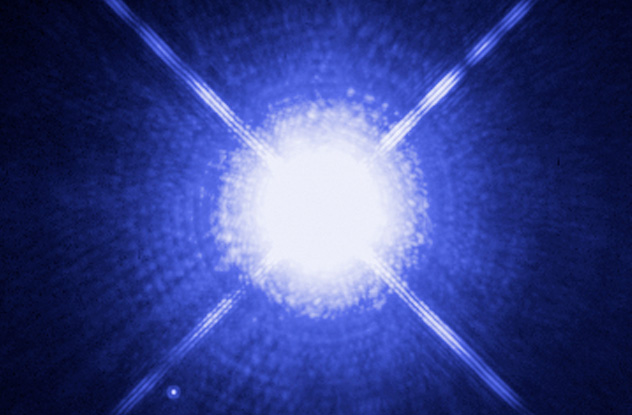 Weird Stuff
Weird Stuff  Weird Stuff
Weird Stuff  Our World
Our World 10 Ways Your Christmas Tree Is More Lit Than You Think
 Movies and TV
Movies and TV The 10 Coolest Stars to Set Sail on The Love Boat
 History
History 10 Things You Didn’t Know About the American National Anthem
 Technology
Technology Top 10 Everyday Tech Buzzwords That Hide a Darker Past
 Humans
Humans 10 Everyday Human Behaviors That Are Actually Survival Instincts
 Animals
Animals 10 Animals That Humiliated and Harmed Historical Leaders
 History
History 10 Most Influential Protests in Modern History
 Creepy
Creepy 10 More Representations of Death from Myth, Legend, and Folktale
 Technology
Technology 10 Scientific Breakthroughs of 2025 That’ll Change Everything
 Weird Stuff
Weird Stuff Ten Bizarre Facts About The Doge Meme
 Our World
Our World 10 Ways Your Christmas Tree Is More Lit Than You Think
 Movies and TV
Movies and TV The 10 Coolest Stars to Set Sail on The Love Boat
Who's Behind Listverse?

Jamie Frater
Head Editor
Jamie founded Listverse due to an insatiable desire to share fascinating, obscure, and bizarre facts. He has been a guest speaker on numerous national radio and television stations and is a five time published author.
More About Us History
History 10 Things You Didn’t Know About the American National Anthem
 Technology
Technology Top 10 Everyday Tech Buzzwords That Hide a Darker Past
 Humans
Humans 10 Everyday Human Behaviors That Are Actually Survival Instincts
 Animals
Animals 10 Animals That Humiliated and Harmed Historical Leaders
 History
History 10 Most Influential Protests in Modern History
 Creepy
Creepy 10 More Representations of Death from Myth, Legend, and Folktale
 Technology
Technology 10 Scientific Breakthroughs of 2025 That’ll Change Everything
10 Puzzling Cosmic Mysteries That We Recently Solved
Astronomers’ discoveries often lead to more questions without answering the ones we already have. But within the last year, scientists solved 10 cosmic mysteries that had puzzled them for years.
10What Is That Bizarre Object In The Center Of Our Galaxy?

For a long time, astronomers have tried to figure out the nature of G2, an unexplained body in the center of our galaxy. At first, they thought G2 was a hydrogen gas cloud moving toward the huge black hole in our Milky Way. But G2 wasn’t acting like a hydrogen cloud caught in a black hole’s gravitational pull. If it had been, G2 would have exploded in a massive fireworks show that would have significantly altered the black hole. Instead, G2 remained in orbit, largely unchanged.
A team of astronomers from UCLA finally solved the puzzle using the advanced telescopes at Hawaii’s W.M. Keck Observatory. Through adaptive optics, these telescopes compensated for the distortion from Earth’s atmosphere to give a clearer picture of space in the vicinity of the black hole.
The astronomers learned that G2 is an enormous star surrounded by gas and dust that probably resulted from the merger of a pair of binary stars. Gravity from a black hole causes this type of merger and may ultimately create an entire class of merged binary stars similar to G2 close to the black hole. This type of merged star will expand for more than one million years then eventually settle down.
The expanding G2 is also experiencing “spaghetti-fication,” otherwise known as elongation, which is a common occurrence among large objects close to a black hole.
9Do Nearby Dwarf Galaxies Have The Right Stuff?

The Milky Way is the largest galaxy in a group of galaxies united by gravity. Our closest neighboring galaxies are known as dwarf spheroidal galaxies. Astronomers wondered if these nearby dwarf galaxies have the conditions to form stars like we see in dwarf irregular galaxies that are over 1,000 light-years from the edge of the Milky Way (but not bound to our galaxy by gravity). These distant dwarf galaxies contain large amounts of neutral hydrogen gas, which powers the formation of stars.
Using sensitive radio telescopes, astronomers found that dwarf galaxies orbiting within a certain boundary around the Milky Way have absolutely no hydrogen gas to form stars. The Milky Way is the culprit—more specifically, the halo of hot hydrogen plasma surrounding our galaxy. When nearby dwarf galaxies orbit the Milky Way, the pressure from the speed of their orbits peels away the galaxies’ neutral hydrogen gas. So these galaxies are unable to form stars.
8How Much Dark Matter Is There Really?

According to the Lambda Cold Dark Matter theory, the most recent explanation of galaxy formation, we should be able to see with the naked eye several large satellite galaxies around our own Milky Way galaxy. But we can’t.
So astrophysicist Dr. Prajwal Kafle from the University of Western Australia decided to find out why by measuring the amount of dark matter in the Milky Way. “Stars, dust, you and me, all the things we see, only make up about 4 percent of the entire universe,” he said. “About 25 percent is dark matter, and the rest is dark energy.”
Using a technique from 1915 (before dark matter was even discovered), Kafle measured the amount of dark matter in our galaxy by making a detailed study of the speed of stars in the Milky Way. He even looked at the edges of our galaxy. His new measurement showed that we have 50 percent less dark matter in our galaxy than astronomers once believed.
Using Kafle’s new dark matter measurement, the Lambda Cold Dark Matter theory predicts that we should see just three satellite galaxies around the Milky Way. That is consistent with what astronomers do see: the Small Magellanic Cloud, the Large Magellanic Cloud, and the Sagittarius Dwarf Galaxy. Dr. Kafle solved a mystery that’s haunted astronomers for about 15 years.
The scientists were also able to measure the speed needed to escape our galaxy’s gravity—550 kilometers (350 mi) per second. That’s 50 times faster than the speed required for a rocket to leave Earth’s surface.
7What Happens In An Exploding Star?

Using radio interferometry (blending data from several radio telescopes to produce a clearer picture), astronomers in December 2013 were able to see a star go nova—an exploding star. This allowed them to solve the mystery of the creation of gamma rays, high-energy electromagnetic radiation.
As Tim O’Brien of the University of Manchester explained, “A nova occurs when gas from a companion star falls onto the surface of a [dying] white dwarf star in a binary system [two stars that orbit each other]. This triggers a thermonuclear explosion on the surface of the star, which blasts the gas into space at speeds of millions of miles per hour.”
Sometimes, a nova produces a new star, but the explosion is hard to predict. The ejected material goes outward, moving quickly along the stars’ orbital plane. After a while, an even faster outward flow of particles from the white dwarf star collides with the slower-moving matter. The resulting shock speeds up the particles enough to create gamma rays.
6Why Isn’t There A Face On The Far Side Of The Moon?

Since 1959, when Soviet spaceship Luna 3 let us see the far side of the Moon for the first time, astronomers have puzzled over the Lunar Farside Highland Problem. No one could explain why the far side looked so different from the Moon’s Earth-facing side. The far side was a patchwork of craters and mountains, but it had almost no maria (dark areas made up of flat seas of basalt) as we see on the Earth-facing side. The maria produce the face of the man in the Moon.
Penn State astrophysicists believe they’ve solved the mystery. The lack of maria on the far side of the Moon reflects the thicker crust with a greater accumulation of aluminum and calcium.
One theory suggests that an object about the size of Mars once collided with Earth. Along with the Earth’s outer layers, it was ejected into space to eventually form the Moon. But a tidal lock between the Earth and Moon kept the same side of the Moon always facing the molten Earth. That Earth-facing side of the moon stayed hot, while the far side of the Moon cooled slowly. This produced a thicker crust on the far side.
The Penn State astrophysicists think that this thicker crust prevented magmatic basalt from coming to the surface. Meteoroids supposedly pierced the thinner crust on the Earth-facing side of the Moon and released basaltic lava, which formed the maria that create the man in the Moon.
But MIT researchers say new information from NASA’s GRAIL mission shows that the man in the Moon may have been caused by a large plume of magma inside the Moon, not an asteroid strike. However, the MIT group isn’t sure how the plume arose. They probably can’t confirm their theory without another lunar mission.
5What The Heck Is That Glow In Space?

If you look at a clear sky at night, you’ll see lots of stars. Using a small telescope, you’ll see planets, nebulae, and galaxies, too. But if you use an X-ray detector, you’ll see the bright glow of X-rays throughout the sky, which is known as the diffuse X-ray background.
The source of the glow has been a mystery for about 50 years. There are three possibilities. It could originate from beyond our solar system, it could come from a “local hot bubble” of gas, or it could be produced within our solar system. Researchers launched a NASA rocket to measure the diffuse X-ray emission and were finally able to solve the mystery.
Most of the emission comes from the local hot bubble of gas hundreds of light-years from Earth with the rest (which is no more than 40 percent) of the emission produced within our solar system, only a few astronomical units from Earth. The hot bubble may have been caused by stellar winds and supernova explosions that create large holes in the space between the stars. If another supernova occurs within that empty area, hot gas that emits X-rays may create a bubble.
X-rays are also emitted inside our solar system when solar wind, which is a release of charged particles from the Sun, hits neutral hydrogen and helium. Until astronomers could explain the glow in the sky, Massimiliano Galeazzi of the University of Miami summed up the mystery this way: “[It’s] like traveling at night and seeing a light, not knowing if the light comes from 10 yards or 1,000 miles away.”
Now we know it’s a little of both.
4What Is The Actual Distance To The ‘Seven Sisters’?

Pleiades, also known as the “Seven Sisters,” is a famous star cluster in the Taurus constellation. It is considered by astronomers to be a cosmic laboratory of hundreds of young stars that formed around 100 million years ago. Scientists used Pleiades to understand how star clusters are created. It’s also helpful as a baseline measuring tool for determining the distance to other star clusters.
Initially, astronomers agreed that Pleiades was approximately 430 light-years from Earth. But then Hipparcos, a European satellite that was supposed to more accurately measure the distance to thousands of stars, calculated the distance to Pleiades as 390 light-years. “That may not seem like a huge difference, but to fit the physical characteristics of the Pleiades stars, it challenged our general understanding of how stars form and evolve,” explained Carl Mellis of the University of California.
Using a network of radio telescopes, astronomers measured the distance to Pleiades with the parallax technique, in which scientists looked at the shift in Pleiades when viewed from the opposite ends of the Earth’s orbit around the Sun. This new measurement was 443 light-years, which is believed to be within 1 percent of the precise distance from Earth to Pleiades. This means Hipparcos was wrong, which opens up new questions about the accuracy of the distances it calculated to 118,000 other stars.
3How Big Is Our Galactic Neighborhood?

Using sensitive radio telescopes to establish where superclusters of galaxies have boundaries, astronomers discovered that our Milky Way galaxy belongs to a recently defined ginormous supercluster called “Laniakea” (“immense heaven,” in Hawaiian). The name was chosen in honor of Polynesian navigators who sailed the Pacific Ocean using the heavens to guide them.
Containing 100,000 galaxies, the Laniakea Supercluster has a diameter of 500 million light-years and a mass of 100 million billion suns. The Milky Way is located on the fringe of Laniakea. Astronomers also developed better information on the Great Attractor, the focal point of gravity within our region of intergalactic space that attracts our local group of galaxies inward and influences the movement of other galaxy clusters.
“We have finally established the contours that define the supercluster of galaxies we can call home,” said R. Brent Tully of the University of Hawaii. “This is not unlike finding out for the first time that your hometown is actually part of a much larger country that borders other nations.”
2What Ominous Fate Awaits Earth?

Astronomers are engaging in a type of celestial archaeology, where they study ruins of planets after their host stars die. The initial findings suggest an ominous fate for Earth.
It all started as a mission to solve the mystery of how dying white dwarf stars become polluted. A white dwarf’s atmosphere, which should be pure hydrogen or pure helium, is often contaminated by heavier elements such as carbon, iron, and silicon.
Originally, scientists believed that the elements were pushed to the surface by extreme radiation from deep within the star. But using a powerful telescope to do an in-depth analysis, the astronomers were able to see the fingerprints of elements like carbon, phosphorus, silicon, and sulfur when these elements were in the white dwarf’s atmosphere. The stars with contaminated atmospheres showed a higher ratio of silicon to carbon than usually seen in stars. In fact, it was the same ratio found in rocky planets.
“The mystery of the composition of these stars is a problem we have been trying to solve for more than 20 years,” said Professor Martin Barstow of the University of Leicester. “It is exciting to realize that they are swallowing up the leftovers from planetary systems, perhaps like our own.”
So that’s the ominous fate that awaits Planet Earth. Billions of years from now, our planet will be little more than rocky pollution in the dying remnants of the Sun.
1How Will Our Galaxy End?

By solving a mystery concerning how galaxies evolve, researchers also developed a better understanding of the fate of our Milky Way galaxy. They know the evolution of some galaxies is affected by supermassive black holes in their centers, just as we have in the Milky Way. These black holes expel almost all of the cold gas from the affected galaxies. Without cold gas, these galaxies can’t form new stars.
While the outflows of molecular hydrogen gas are an accepted part of the theory of galactic evolution, researchers were puzzled by how these outflows of gas were accelerated. Using advanced telescopes to study neighboring galaxy IC5063, scientists found that high-energy jets of electrons, propelled by central black holes, accelerate the outflow of molecular hydrogen gas.
This also points to the eventual outcome for our Milky Way galaxy, which is predicted to collide with our galactic neighbor, Andromeda, in approximately five billion years. When the two galaxies collide, gas will accumulate in the system’s center and power its supermassive black hole. That will cause jets to form and will eject any gas left in the galaxy. When that happens, the merged galaxy won’t be able to form new stars.
+Is It All Just An Illusion?

We think we understand more and more about our universe. But scientists at the US Department of Energy’s Fermi National Accelerator Laboratory are using a laser analysis project called the Holometer to see if we actually live in a hologram. That would mean our 3-D world is merely an illusion, with everything really encoded in tiny 2-D packets.
It would be similar to how TV show characters believe they live in a 3-D world, but they’re trapped on a 2-D screen. Scientists believe the information in our universe may be contained in packets like how the pixels on a TV screen contain data points. When you stand close to your TV, you can see individual pixels. But when you move farther back, all the pixels seem to form one image.
It’s possible that our world is defined that way, with our “pixel” of space equal to an area about 10 trillion trillion times smaller than an atom. “We want to find out whether space-time is a quantum system just like matter is,” said Craig Hogan of Fermilab. “If we see something, it will completely change ideas about space we’ve used for thousands of years.”
Maybe it will be our world’s Twilight Zone moment.








